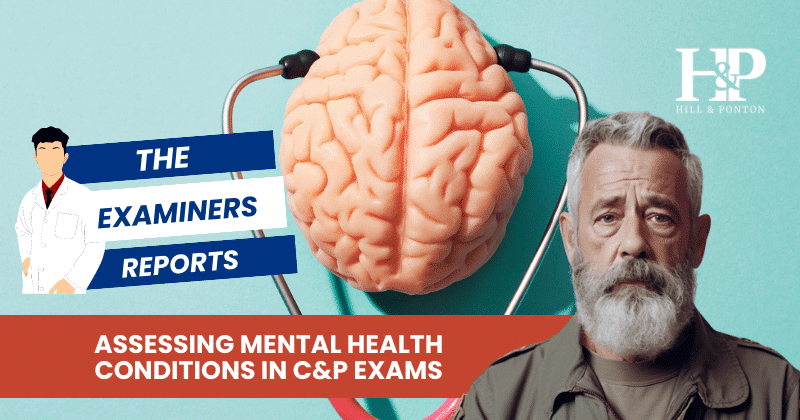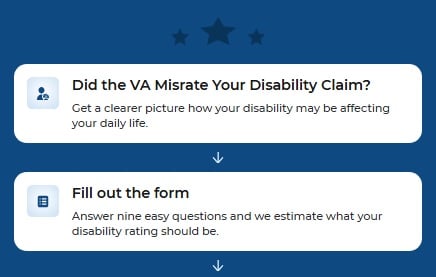VA ratings for mental health disorders like PTSD, depression or anxiety follow specific criteria based on how they affect your daily life and ability to work. Our collection of guides, tools, and expert advice can help you navigate the VA claims process, understand potential rating changes, and access the benefits you’ve rightfully earned.
Whether you’re filing your first claim, appealing an unfavorable decision, or looking to increase your current mental health rating, you’ll find below all the information you need for the next step on your road to VA disability compensation.
Resources

The Veteran’s PTSD Guide
A complete, easy-to-understand guide to getting VA compensation and assistance for PTSD.

Suicide Risk and Prevention
Veteran suicide statistics, risk factors and resources for veterans, their families and friends.

C&P Exams for Mental Disorders
A VA medical examiner explains mental health C&P exams and how to best prepare for them.

Mental Health Rating Tool
This will help you understand if the VA may have assigned the wrong rating to your mental disorder.
VA’s Formula for Rating Mental Health Conditions
The VA assigns mental health ratings ranging from 0% (for symptoms that don’t interfere with occupational and social functioning and don’t require continuous medication) to 100% for total impairment, according to the criteria in the General Rating Formula for Mental Disorders in the VA’s schedule of ratings.
| Rating | General Rating Formula for Mental Disorders |
|---|---|
| 100% | Total occupational and social impairment, due to such symptoms as: gross impairment in thought processes or communication; persistent delusions or hallucinations; grossly inappropriate behavior; persistent danger of hurting self or others; intermittent inability to perform activities of daily living (including maintenance of minimal personal hygiene); disorientation to time or place; memory loss for names of close relatives, own occupation, or own name. |
| 70% | Occupational and social impairment, with deficiencies in most areas, such as work, school, family relations, judgment, thinking, or mood, due to such symptoms as: suicidal ideation, obsessional rituals which interfere with routine activities; speech intermittently illogical, obscure, or irrelevant; near-continuous panic or depression affecting the ability to function independently, appropriately and effectively; impaired impulse control (such as unprovoked irritability with periods of violence); spatial disorientation; neglect of personal appearance and hygiene; difficulty in adapting to stressful circumstances (including work or a work-like setting); inability to establish and maintain effective relationships |
| 50% | Occupational and social impairment with reduced reliability and productivity due to such symptoms as: flattened affect; circumstantial, circumlocutory, or stereotyped speech; panic attacks more than once a week; difficulty in understanding complex commands; impairment of short – and long-term memory (e.g., retention of only highly learned material, forgetting to complete tasks); impaired judgment; impaired abstract thinking; disturbances of motivation and mood; difficulty in establishing and maintaining effective work and social relationships. |
| 30% | Occupational and social impairment with occasional decrease in work efficiency and intermittent periods of inability to perform occupational tasks (although generally functioning satisfactorily, with routine behavior, self-care, and conversation normal), due to such symptoms as: depressed mood, anxiety, suspiciousness, panic attacks (weekly or less often), chronic sleep impairment, mild memory loss (such as forgetting names, directions, recent events). |
| 10% | Occupational and social impairment due to mild or transient symptoms which decrease work efficiency and ability to perform occupational tasks only during periods of significant stress, or symptoms controlled by continuous medication |
| 0% | A mental condition has been formally diagnosed, but symptoms are not severe enough either to interfere with occupational and social functioning or to require continuous medication. |
This General Rating Formula for Mental Disorders is used for all mental health conditions with the exception of eating disorders which have their own criteria. So whether your disability is PTSD, Adjustment Disorder, Anxiety, or Depression, the VA rates all of these disabilities on the same rating schedule, looking at the same range of symptoms.
The use of the general formula is often beneficial to a veteran being treated by multiple doctors, who may assign different diagnoses to complex psychological issues. It’s also important to know that a veteran need not suffer from every symptom listed. The VA is supposed to look at all of the veteran’s symptoms and determine into which category he or she most closely fits. A veteran should make sure to report all of the symptoms experienced, whether they are on the list or not, so that VA can appropriately consider the veteran’s entire mental disability picture when assigning a rating.
Proposed Changes in Mental Ratings
(Not Yet In Place)
There is a proposal to revise the rating criteria for mental health conditions, which could result in higher ratings for veterans with severe symptoms. The VA also aims to streamline the claims process for mental health conditions, making it quicker and easier for veterans to access benefits and treatment. 2025 update: these changes are not yet in effect and it is not clear when or if the VA will apply them.
If the new rating system is applied, instead of just looking at how your mental health affects your work and social life, the VA will look at five specific areas:
- Thinking and Understanding: Your memory, concentration, decision-making, and problem-solving
- Getting Along with Others: How you interact with people in social settings and at work
- Completing Tasks: Your ability to handle work, education, and daily chores
- Moving Around: Your ability to leave home, use transportation, and navigate different places
- Taking Care of Yourself: Things like hygiene, dressing, and eating properly
For each of these five areas, the VA will look at how severe your problems are (none, mild, moderate, severe, or total) and how often they happen (less than 25% of the time or 25% and more).
These two factors will give you a score from 0-4 in each area. Your final disability rating (10%, 30%, 50%, 70%, or 100%) will depend on how many areas are affected and how badly. It should make it possible to get the highest ratings even if only one area has total impairment.
Keep Up with the VA: We’ll Let You Know When Rating Criteria Change
Stay updated